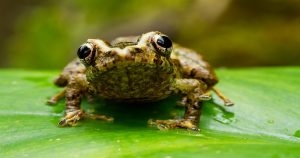
‘Heredia Robber Frog’ Assumed As Extinct Now Reappears In California After 30 Years
There is always something that is present beyond the hands of human beings, sometimes we deliberately end up unnoticing the things around us, sometimes we simply conclude the subject when it appears out of context or our eye. Here is a surprising incident when scientists discovered a species which was assumed as extinct about 30 years back.
The scientists from Costa Rican has reported on Tuesday about the reappearance of an endemic frog species that had been declared extinct by the International Union for Conservation of Nature (UICN) in the year 2004 and which had not been sighted for three decades.
Related Articles: 499 More Species Added To India’s Biodiversity Riches
Coming to the details, the Heredia robber frog, whose scientific name is Craugastor escoces, was spotted by Costa Rican biologists Gilbert Alvarado and Randall Jimenez in the Juan Castro Blanco National Park in Alajuela province.
Alvarado, who played a vital role in this discovery told in a press conference, “There are 34 species of this kind (Craugastor) from Mexico to Panama. In Costa Rica, there are eight of them and in the 1990s, all of those living above an altitude of 1,000 meters (3,280 feet) disappeared or nothing more was known of them. This one (the Heredia robber frog) was declared extinct in 2004 but now we’re going to bring it back.”
According to the sources, the discovery occurred on Sept. 19, 2016, while collecting a sample of amphibians. The frog that was found is a coffee-colored adult female with a red belly and measures 6.2 centimeters (3 1/4 inches).
It was in 1986 that the frog was last seen. Following its absence, later in 2004, the UICN declared three amphibians extinct: this robber frog and Holdridge’s toad, also known as the deaf-and-dumb toad. The only one still on the extinct list is the golden toad, which researchers consider the first victim of global warming.
When asked about losing the species, Alvarado said:
“Hard blow for science and for biodiversity, because they represent years of evolution and each one has a biological function within the ecosystem. Knowing that the robber frog is there means recovering genetic material of incalculable value.”
It is reported that the discovery occurred in a ravine at an altitude of 1,820 meters, which makes researchers think there must be a robber frog population surviving there, however, very little is known about the species because it had been studied very little.
The official data indicate that in this Central American country there are more than 200 species of frogs and toads out of which Costa Rica has 4.7 million inhabitants which are close to 4.5 percent of the biodiversity on the planet, being one of the top 20 countries in the world for biodiversity altogether.